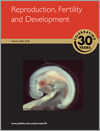Reproduction, Fertility and Development
Volume 30
Number 5 2018
Due to fetal and neonatal bone tissue calcification, the maternal calcium demand increases during pregnancy and lactation. To supply this calcium demand, female mammals undergo numerous physiological changes during reproduction. In the present study, we performed a meta-analysis of studies reporting changes in bone mineral density, serum calcium and calciotropic hormone concentrations during pregnancy and lactation in mammals. The results provide a quantitative background to better explain and understand these physiological adaptations.
The reason why some spermatozoa reach the site of fertilisation where others fail is not known, but interaction between spermatozoa and the female environment is key. We profiled ‘winner’ and ‘loser’ spermatozoa and found that the sugars on their surface and their susceptibility to immune cell attack differed significantly. This helps to explain both normal reproductive physiology and the consequences of human intervention.
Nutritional perturbation during early gestation has been shown to alter male reproductive development in rodents and sheep. This study examined the effects of dietary protein perturbation during the peri-conception and first trimester periods upon reproductive development in both fetal and pubertal male bovine progeny. Low maternal dietary protein negatively impacted reproductive development in pubertal and postpubertal offspring. This research highlights that further studies are warranted to explore causal relationships between gestational nutrition and consequent postnatal male reproductive development in cattle.
The zona pellucida (ZP) is an extracellular matrix formed by a few glycoproteins that covers the oocyte and plays an important role during fertilization. The identification of the components of the ZP in marsupials is relevant for the cellular understanding of female gamete formation, sperm interaction with the ZP and fertilisation. Molecular and in silico analyses demonstrated a different ZP composition between Australasian and South American marsupials, being formed from four to six proteins. The present findings have potential relevance from a biological, ecological and economic point of view, related to the development of new contraceptive vaccines for marsupials.
The Kiss1 gene plays a major role in reproductive seasonality of sheep. This study aimed to confirm that epigenetic modification occurs in sheep during the reproductive cycle. A potential role of histone acetylation modification in altering Kiss1 expression, which may consequently regulate seasonal breeding in sheep, was found. This study may offer a theoretical basis for breeding year-round oestrous sheep.
Female sperm storage is known across many animal phyla, but the mechanism(s) remains elusive. Using the Indian garden lizard, Calotes versicolor as a model, we identified a unique abundant protein of ~55-kDa in the uterovaginal region that controls the motility of the spermatozoa. These studies are likely to unravel the secrets of sperm storage.
The molecules that are involved in actin-based oocyte polar body extrusion are still largely unknown. In the present study we showed that knockdown of Profilin caused aberrant actin distribution, the failure of polar body extrusion and altered the expression of Rho-associated kinase (ROCK) and myosin light chain (MLC) 2. The results indicate that Profilin is related to ROCK–MLC2 for actin assembly in mouse oocytes.
N-carbamylglutamate (NCG) and arginine (ARG) supplementation can increase litter size in pigs and rats, but their effects on gonadotrophin-releasing hormone (GnRH) secretion are unknown. We found that NCG and ARG can increase cell numbers and decrease GnRH secretion in murine immortalized GT1-7 cells in vitro by regulating related gene expression. These findings help us to better understand nutritional control of reproduction.
The preimplantation period of pregnancy is a critical period for determining growth of the conceptus. This study examined the use of progesterone treatment as a means of overcoming maternal constraint effects on embryo growth. Exogenous progesterone was found to indirectly advance embryo growth via alteration of endometrial genes that encode for uterine structural and secretory activity and thereby overcome maternal constraint.
This article contributes to a better understanding of which transcripts are involved in early embryonic development, when the embryos still rely on the maternal genetic component and after they activate their own genome. We identified the thyroid hormone receptor, especially the β-subunit, as one of the few genes transcribed before major embryonic genome activation with an essential role for development.




